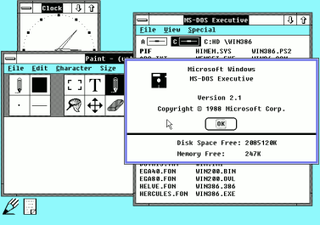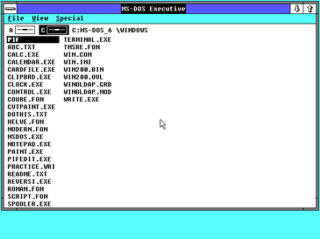Related Research Articles

Microsoft PowerPoint is a presentation program, created by Robert Gaskins and Dennis Austin at a software company named Forethought, Inc. It was released on April 20, 1987, initially for Macintosh computers only. Microsoft acquired PowerPoint for about $14 million three months after it appeared. This was Microsoft's first significant acquisition, and Microsoft set up a new business unit for PowerPoint in Silicon Valley where Forethought had been located.

Adobe PageMaker is a discontinued desktop publishing computer program introduced in 1985 by the Aldus Corporation on the Apple Macintosh. The combination of the Macintosh's graphical user interface, PageMaker publishing software, and the Apple LaserWriter laser printer marked the beginning of the desktop publishing revolution. Ported to PCs running Windows 1.0 in 1987, PageMaker helped to popularize both the Macintosh platform and the Windows environment.
DataFlex is an object-oriented high-level programming language and a fourth generation visual tool 4GL for developing Windows, web and mobile software applications on one framework-based platform. It was introduced and developed by Data Access Corporation beginning in 1982.
Merge is a software system which allows a user to run DOS/Windows 3.1 on SCO UNIX, in an 8086 virtual machine.
CommSuite 95 is a communications software suite launched in 1995 by Canadian software company Delrina.

Microsoft Write is a basic word processor included with Windows 1.0 and later, until Windows NT 3.51. Throughout its lifespan it was minimally updated, and is comparable to early versions of MacWrite. Early versions of Write only work with Write Document (.wri) files, which are a subset of the Rich Text Format (RTF). After Windows 3.0, Write became capable of reading and composing early Word Document (.doc) files. With Windows 3.1, Write became OLE capable. In Windows 95, Write was replaced with WordPad; attempting to open Write from the Windows folder will open WordPad instead.
Mosaic was a Macintosh scorewriter application for producing music notation, developed by Mark of the Unicorn.
LiveWire Professional is a MS-DOS program made by CableSoft. It was first introduced in 1988 as software/expansion board combination, which allowed to convert Financial News Network ticker from television receivers into ASCII for further analysis. The software is designed for stock brokers and financial analysts, allowing them to record and analyse the stock market, through the use of live feeds. However, its user interface was criticized as cumbersome.
Connect Business Information Network, formerly known as MacNET, was a proprietary dial-up online network with a graphic user interface similar to AppleLink.
Meeting Maker is a cross-platform personal calendar and group scheduling software application from PeopleCube. First released in 1991 for Macintosh by ON Technology, support for other platforms followed in 1993 with Meeting Maker XP. Alongside Windows and Mac, native clients were released for OS/2 and Solaris, and later also for other platforms. Some support was also introduced for mobile platforms like Apple Newton, PalmPilot and Windows CE. Although powerful, its user interface - aiming at uniformity across multiple platforms — was criticized as weak and not supporting all features of target platforms.
Aldus PhotoStyler was a graphics software program developed by the Taiwanese company Ulead. Released in June 1991 as the first 24 bit image editor for Windows, it was bought the same year by the Aldus Prepress group. Its main competition was Adobe Photoshop. Version 2.0 introduced a new user interface and improved color calibration. PhotoStyler SE - lacking some features of the version 2.0 - was bundled with scanners like HP ScanJet. The product disappeared from the Adobe product line after Adobe acquired Aldus in 1994.
Courier was an email client for Microsoft Windows. The software was originally released in 1996 as Calypso by Micro Computer Systems (MCS).

Windows 2.1 is a major release of Microsoft Windows. It was released to manufacturing on May 27, 1988, as a successor to Windows 2.0.

Windows 3.1 is a major release of Microsoft Windows. It was released to manufacturing on April 6, 1992, as a successor to Windows 3.0.

Windows 2.0 is a major release of Microsoft Windows, a family of graphical operating systems for personal computers developed by Microsoft. It was released to manufacturing on December 9, 1987, as a successor to Windows 1.0.
The Zinc Application Framework is an application framework, intended for the development of cross-platform software applications with graphical user interface (GUI), using a widget toolkit. Zinc targets both embedded and desktop platforms.
Paracomp was a Macintosh programming company known for their 3D software, Swivel 3D and ModelShop and FilmMaker. FilmMaker was known for its packaging which was a 16mm film reel tin which was used to contain the software and manuals. Paracomp was also the publisher of the computer algebra system Milo, which was the first program on Macintosh able to perform symbolic computation using standard math notation. Paracomp was acquired by MacroMind in 1991 to briefly form MacroMind-Paracomp, before adding Authorware in 1992 and becoming Macromedia.

Chuck Colby was an electronics engineer and chief-inventor, founder and president of Colby Systems Corporation, a company that created the first DVR-based video surveillance systems but is also very notable as a pioneer in portable computing, being the first to market both DOS and Macintosh portable computers, as well as a remarkable number of other technological firsts.
LINDO is a software package for linear programming, integer programming, nonlinear programming, stochastic programming and global optimization.

Dr. Halo is a raster graphics editor developed by Media Cybernetics and released for computers running MS-DOS. It was among the first graphics editors available for MS-DOS with its initial release in 1984. Media Cybernetics boasted about three million users of Dr. Halo between 1984 and 1993.
References
- 1 2 Wortman, Leon A. (November 26, 1984). "Macack, Mactep, Red Ryder". InfoWorld. Vol. 6, no. 48. IDG. pp. 63–66. ISSN 0199-6649.
- 1 2 3 4 5 6 7 8 9 Wiggins, Robert R.; Bobker, Steven (December 1987). "A Perfect 10". MacUser. Vol. 3, no. 12. Ziff-Davis Publishing. pp. 152, 154, 156, 158. ISSN 0884-0997.
- 1 2 Wiggins, Robert R. (July 1986). "3-Ring Circuits". MacUser. Vol. 1, no. 10. MacUser Publications. pp. 68–72, 138. ISSN 0884-0997.
- 1 2 Bobker, Steven (January 1988). "Fixing What Ain't Broke". MacUser. Vol. 4, no. 1. Ziff-Davis Publishing. p. 15. ISSN 0884-0997.
- ↑ Wiggins, Robert R. (May 1990). "White Knight". MacUser. Vol. 6, no. 5. Ziff-Davis Publishing. pp. 106, 110. ISSN 0884-0997.
- ↑ Heid, Jim (December 1985). "No Static At All". Macworld. Vol. 2, no. 13. PC World Communications. pp. 86–94. ISSN 0741-8647.
- ↑ Arnett, Nick (March 20, 1989). "Open Lines of Communication". InfoWorld. Vol. 11, no. 12. IDG. pp. S1, S2, S4–S8, S10–S11. ISSN 0199-6649.